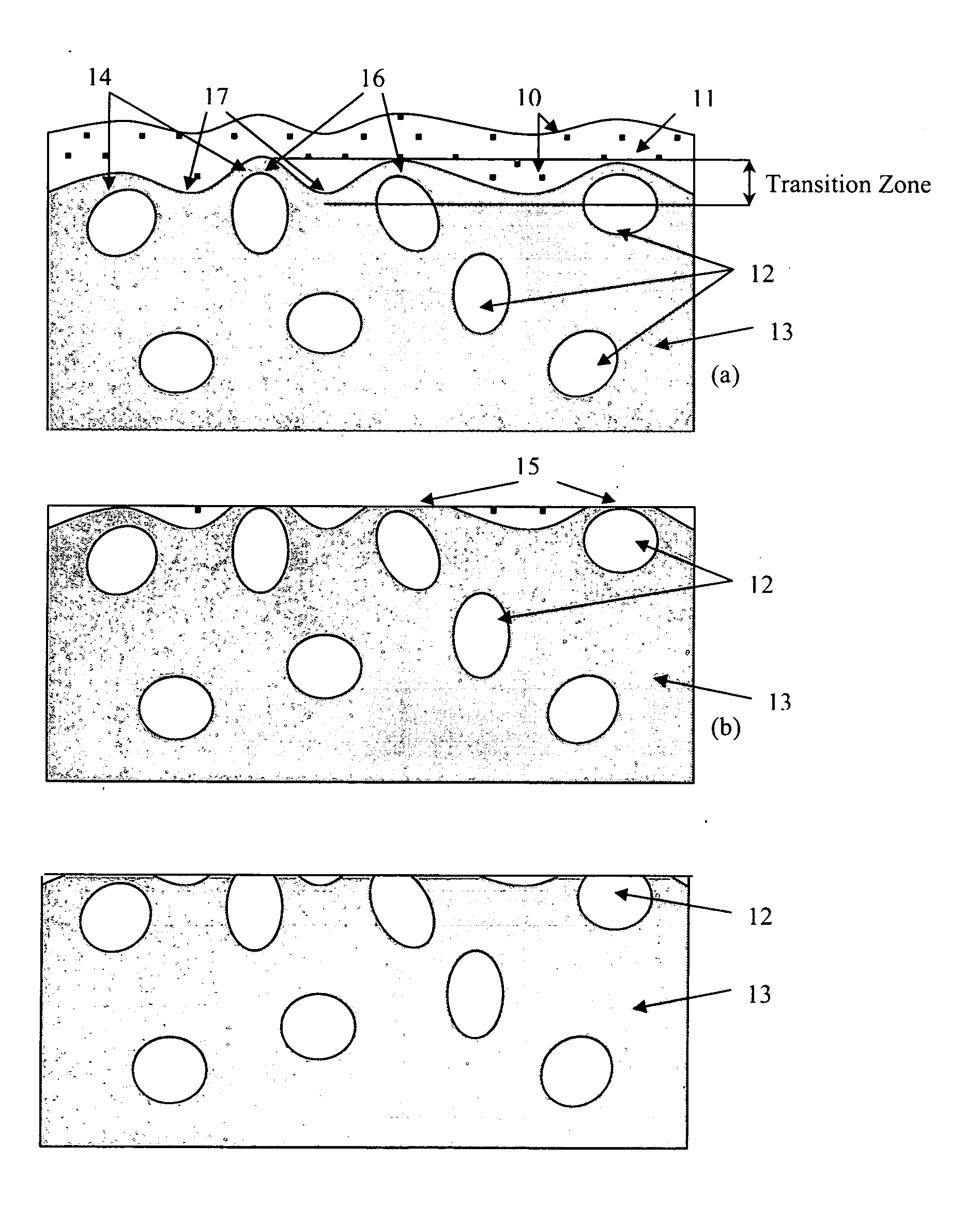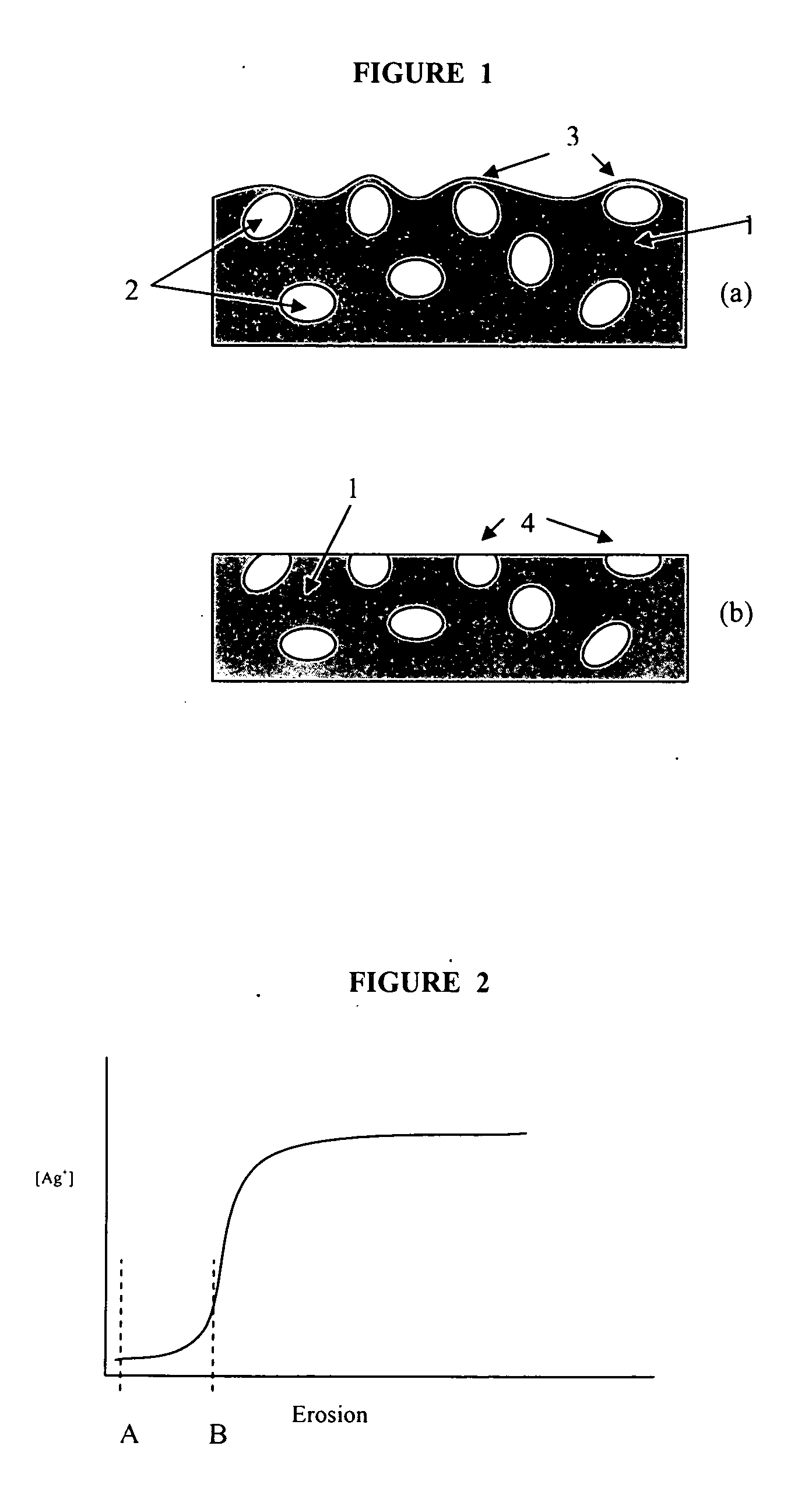Antimicrobial coating for erosive environments
- Summary
- Abstract
- Description
- Claims
- Application Information
AI Technical Summary
Benefits of technology
Problems solved by technology
Method used
Image
Examples
example 1
[0082] A base coat coating composition was prepared from a two-part cycloaliphatic amine epoxy coating system from Carboline Company, St. Louis, Mo. (Carboline 892) using 74 parts Part A (cycloaliphatic amine) and 100 parts Part B (epoxy resin). To 500 g of the 70% solids mixed base coat composition was added 12 g of a microencapsulated silver zeolite composition. The microencapsulated silver zeolite composition was prepared by microencapsulating 100 parts AgION AJ10D antimicrobial agent (about 2.5% by weight of silver ion-exchanged in Type A zeolite particles having a mean average diameter of about 3μ available from AgION Technologies, Inc., Wakefield, Mass.) with 100 parts of a hydrophilic polyurethane resin (Tecophilic® 60 from Thermedics Inc. of Woburn, Mass.). That fraction of the so formed particles having a particle size of about 40-1 00 microns were employed in this example. The resulting base coat coating composition contained, on a percent (by weight) solids basis, approxi...
example 2
[0089] A 3-part 100% solids, trowellable epoxy flooring system (CORRO-FLOR) consisting of a resin (Part A), a Hardener (Part B) and a grit filler (blended granite or quartz aggregate) plus tint (Part C) obtained from Corro-Shield International, Inc. of Rosemont, Ill. was prepared and employed as a base coat. Prior to mixing, Part C was modified by blending the unmodified Part C with 0.2% by weight of AgION AK10D (5% by weight of silver ion-exchanged in Type A zeolite particles available from AgION Technologies, Inc., Wakefield, Mass.), based on the total weight of the coating, and a small amount of Part A to bond the antimicrobial powder to the grit for ease of incorporation. The coating was then applied to ceramic tiles using a trowel to a thickness of approximately 0.25 inch, in accordance with the manufacturer's instructions.
[0090] Several tiles prepared as set forth in the preceding paragraph were then coated with a hydrophilic acrylic top coat (Clene Coat AC from AgION Technol...
example 3
[0093] The coating system of Example 2 was applied to a real-life environment of a food processing facility. The base coat was applied to the concrete flooring in a number of high to moderate traffic areas. The concrete flooring was first prepped by blast tracking and cleaning. Parts A and B were mixed and the mix applied to the prepped floor sections by roll coating. Part C was then broadcast and back-rolled into the rolled coating, resulting in a coating of approximately 40 mil thickness. Following cure of the epoxy base coat, a 2 mil layer of the formulated acrylic top coat was rolled over the cured epoxy base coat.
[0094] Four treated and two untreated areas of the flooring having similar traffic patterns were selected for bacterial testing. Total Plate Count (TPC) and Listeria testing were performed. In determining the TPC, 2″ by 2″ areas were swabbed with a pre-moistened sponge swab (Spongesicle from International BioProducts) and shipped overnight to the testing facility. Upo...
PUM
| Property | Measurement | Unit |
|---|---|---|
| Fraction | aaaaa | aaaaa |
| Fraction | aaaaa | aaaaa |
| Percent by mass | aaaaa | aaaaa |
Abstract
Description
Claims
Application Information
 Login to View More
Login to View More - R&D
- Intellectual Property
- Life Sciences
- Materials
- Tech Scout
- Unparalleled Data Quality
- Higher Quality Content
- 60% Fewer Hallucinations
Browse by: Latest US Patents, China's latest patents, Technical Efficacy Thesaurus, Application Domain, Technology Topic, Popular Technical Reports.
© 2025 PatSnap. All rights reserved.Legal|Privacy policy|Modern Slavery Act Transparency Statement|Sitemap|About US| Contact US: help@patsnap.com



